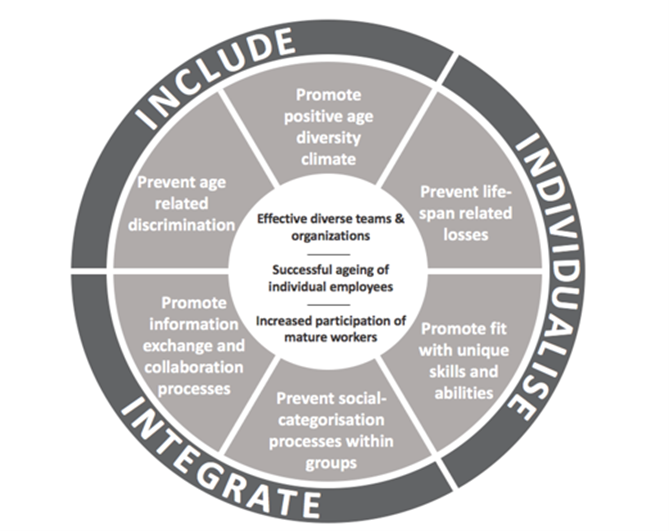Population ageing brings many complex challenges to contemporary workplaces. First, as pressures to increase participation of mature workforce increase, organisations need to work out how to maintain employee motivation, productivity, and wellbeing over a significantly longer working lifespan. Second, with an aging workforce comes increased age diversity, so organisations need to facilitate productive interactions between employees of very different ages. Evidence suggests that when organisations fail to adapt their strategies to address these demographic trends, they can face negative outcomes in terms of productivity and long-term survival.
However, there is insufficient research about what types of work practices and workplace interventions make a positive difference to older workers’ experiences and outcomes. For the past few years, a research team from the Centre of Excellence in Population Ageing Research (CEPAR) has been working with organisations and employees across Australia to fill this gap. The research project, Organisations and the Mature Workforce brings together researchers from Curtin University, Perth, and the University of Sydney. Its main aim is to develop knowledge that guides employers on what management approaches might be most appropriate to support successful ageing at work.
Our research project has two key components. First, we use large scale surveys across various industries to understand wider trends for the Australian mature workforce and the impact of macro level changes such as the COVID-19 pandemic. Second, we work directly with public and private sector organisations to better understand their specific aims and challenges in relation to their ageing workforce. We further assist them in developing and implementing tailored interventions, as well as evaluating the outcomes of these interventions.
While our research is still ongoing, the work we have done for the past few years has led us to elaborate a guiding framework for organisations, which we will shortly describe below.
What enables successful ageing at work? Include, Individualise, Integrate framework
Our research points towards a simple framework that could guide organisations in adapting their strategies to meet the challenges of an ageing and age diverse workforce. The framework, which we often refer to as the “3I” model, focuses on three key areas: Include, Individualise, and Integrate.
Include, Individualise, and Integrate
Include refers to those strategies that are aimed at creating an environment which is not only free from age related stereotypes and discrimination, but also where workers of all ages feel welcomed and valued. Unfortunately, bias and discrimination are still very much part of the work experience of mature Australians. For example, in our research more than 50% of mature workers report that they are not given equal access to training or other opportunities to maintain or upgrade their skills. And only 45% of older workers feel that they have supportive leaders who value their contributions. Furthermore, our large survey of mature workers during COVID showed that levels of age bias experienced by employees at the beginning of the pandemic were predictive of changes in employee wellbeing, performance, and withdrawal indicators at 6 and 12 months after.
Individualise strategies actively target the individual changes that can be associated with ageing. As employees can experience varied age-related losses (for example in cognitive speed or physical strength) as well as gains (such as increased expertise, loyalty, and conscientiousness), strategies like flexible work arrangements, or work redesign can be used to offset the losses and maximise the gains. Unfortunately, in our research employees systematically report only moderate availability of such individualising practices, despite the fact that they are typically associated with higher work engagement, lower turnover, and intention to retire at a later age.
Integrate strategies aim to actively utilise the strengths of mature workers by improving the way age diverse employees interact and work together. Employees of different ages bring a range of work experiences, knowledge, skills, and abilities to the table. Organisations can use these to derive competitive advantage by facilitating knowledge sharing and good collaboration practices. However, if not appropriately managed, increased age diversity can lead to conflict and poor communication. Our research so far indicates that Australian workplaces dedicate the least attention to this critical area. Moreover, integrative strategies appeared to be the most affected during the COVID pandemic compared to pre-pandemic levels signalling possible risks for knowledge loss.

In sum, we urge organisations to carefully reconsider and balance their policies and practices to create a work environment that welcomes, accepts and values employees of all ages (Include), that meets their age specific needs and preferences (Individualise), and fosters collaboration and knowledge exchange (Integrate). However, we also acknowledge that this process is not necessarily easy and can take a long time. But even small changes can have a large impact and can yield long term benefits, not only for our ageing population, but also for organisations. Therefore, we hope our work inspires more organisations to actively consider their approach to the ageing workforce.
Daniela Andrei, PhD
Senior Research Fellow
ARC Centre of Excellence in Population Ageing Research | Future of Work Institute | Curtin University
FIND OUT MORE
https://matureworkers.cepar.edu.au/
https://cepar.edu.au/research/research-program-2017-2024/organisations-and-mature-workforce
